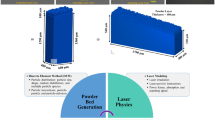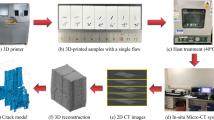Abstract
Porous structural materials are widely adopted in medical field owing to their excellent mechanical and physical properties. The 3D printing technology offers new opportunities for the preparation of porous structures. However, during 3D printing of porous structure, continuous rapid heating and cooling cycles lead to residual stress. Severe quality defects including cracks, warpage, and deformation caused by the residual stress have remained to be a problem. In this study, a development model of residual stress with porous structure was established using fused deposition molding (FDM), and the residual stress was found to have a linear correlation with stress concentration coefficient. Samples with different pass and aperture sizes were fabricated by FDM. The residual stresses developed on the surface of samples were evaluated by Raman spectroscopy. The relationship between pore size and surface residual stress was obtained, indicating that the variation in surface residual stress is consistent with stress concentration coefficient with the increase in pore size. Based on above results, the accuracy of theoretical modeling was confirmed. This development model of residual stress has guiding paramount for 3D printing porous structures.











Similar content being viewed by others
References
L.N. Carter, O. Addison, N. Naji, P. Seres, A.H. Wilman, D.E.T. Shepherd, L. Grover, S. Cox, Acta Biomater. 107, 338 (2020)
S.F.S. Shirazi, S. Gharehkhani, M. Mehrali, H. Yarmand, H.S.C. Metselaar, N. Adib Kadri, N.A.A. Osman, Sci. Technol. Adv. Mater. 16, 033502 (2015)
M. Fattahi, M. Rostami, F. Amirkhanlu, N. Arabian, E. Ahmadi, H. Moayedi, Diam. Relat. Mater. 99, 107518 (2019)
A.H. Nickel, D.M. Barnett, F.B. Prinz, Mater. Sci. Eng. A 317, 59 (2001)
C. Kousiatza, D. Karalekas, Mater. Des. 97, 400 (2016)
C. Kousiatza, N. Chatzidai, D. Karalekas, Sensors (Switzerland) 17, 456 (2017)
B. Vrancken, V. Cain, R. Knutsen, J. Van Humbeeck, Scr. Mater. 87, 29 (2014)
L. Wang, X. Jiang, Y. Zhu, X. Zhu, J. Sun, B. Yan, Int. J. Adv. Manuf. Technol. 97, 3535 (2018)
Y. Zhang, K. Chou, Proc. Inst. Mech. Eng. Part B J. Eng. Manuf. 222, 959 (2008)
M. Kaveh, M. Badrossamay, E. Foroozmehr, A. Hemasian Etefagh, J. Mater. Process. Technol. 226, 280 (2015)
T. Mukherjee, V. Manvatkar, A. De, T. DebRoy, Scr. Mater. 127, 79 (2017)
W.L. Wang, C.M. Cheah, J.Y.H. Fuh, L. Lu, Mater. Des. 17, 205 (1996)
T.B.F. Woodfield, J. Malda, J. De Wijn, F. Péters, J. Riesle, C.A. Van Blitterswijk, Biomaterials 25, 4149 (2004)
J.M. Williams, A. Adewunmi, R.M. Schek, C.L. Flanagan, P.H. Krebsbach, S.E. Feinberg, S.J. Hollister, S. Das, Biomaterials 26, 4817 (2005)
C. Zhou, K. Yang, K. Wang, X. Pei, Z. Dong, Y. Hong, X. Zhang, Mater. Des. 109, 415 (2016)
M. Asadi-Eydivand, M. Solati-Hashjin, A. Farzad, N.A. Abu Osman, Robot. Comput. Integr. Manuf. 37, 57 (2016)
M.F. Zaeh, G. Branner, Prod. Eng. 4, 35 (2010)
D.A. Lesyk, S. Martinez, B.N. Mordyuk, V.V. Dzhemelinskyi, A. Lamikiz, G.I. Prokopenko, Surf. Coatings Technol. 381, 125136 (2020)
W. Zhang, A.S. Wu, J. Sun, Z. Quan, B. Gu, B. Sun, C. Cotton, D. Heider, T.W. Chou, Compos. Sci. Technol. 150, 102 (2017)
L. Mugwagwa, D. Dimitrov, S. Matope, I. Yadroitsev, Int. J. Adv. Manuf. Technol. 102, 2441 (2019)
A. Kantaros, D. Karalekas, Mater. Des. 50, 44 (2013)
C. Casavola, A. Cazzato, V. Moramarco, G. Pappalettera, Polym. Test. 58, 249 (2017)
H. Ali, H. Ghadbeigi, K. Mumtaz, Int. J. Adv. Manuf. Technol. 97, 2621 (2018)
I.A. Alhomoudi, G. Newaz, Thin Solid Films 517, 4372 (2009)
S.H. Margueron, P. Bourson, S. Gautier, A. Soltani, D. Troadec, J.C. De Jaeger, A.A. Sirenko, A. Ougazzaden, J. Cryst. Growth 310, 5321 (2008)
M. Shiomi, K. Osakada, K. Nakamura, T. Yamashita, F. Abe, CIRP Ann. - Manuf. Technol. 53, 195 (2004)
X.W.Shen, Zhejiang University (2018)
Science and Technology Committee of Ministry of aviation industry. In: Handbook of stress concentration factors (1990)
K. Kollins, C. Przybyla, M.S. Amer, J. Eur. Ceram. Soc. 38, 2784 (2018)
Acknowledgements
This project was supported by the Natural Science Foundation of Shandong Provincial, China (Grant No. ZR2017MEE052; No. ZR2018ZB0105) and the Shandong Provincial Key Research and Development Program (Grant No. 2019JZZY010441). Thanks for all the former researches contributed to this study.
Author information
Authors and Affiliations
Corresponding author
Ethics declarations
Conflict of interest
The authors declare that they have no known competing financial interests or personal relationships that could have appeared to influence the work reported in this paper.
Additional information
Publisher's Note
Springer Nature remains neutral with regard to jurisdictional claims in published maps and institutional affiliations.
Rights and permissions
About this article
Cite this article
Zhao, L., Jiang, Z., Zhang, C. et al. Development model and experimental characterization of residual stress of 3D printing PLA parts with porous structure. Appl. Phys. A 127, 98 (2021). https://doi.org/10.1007/s00339-020-04238-2
Received:
Accepted:
Published:
DOI: https://doi.org/10.1007/s00339-020-04238-2




